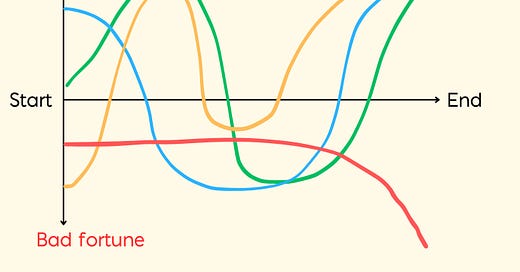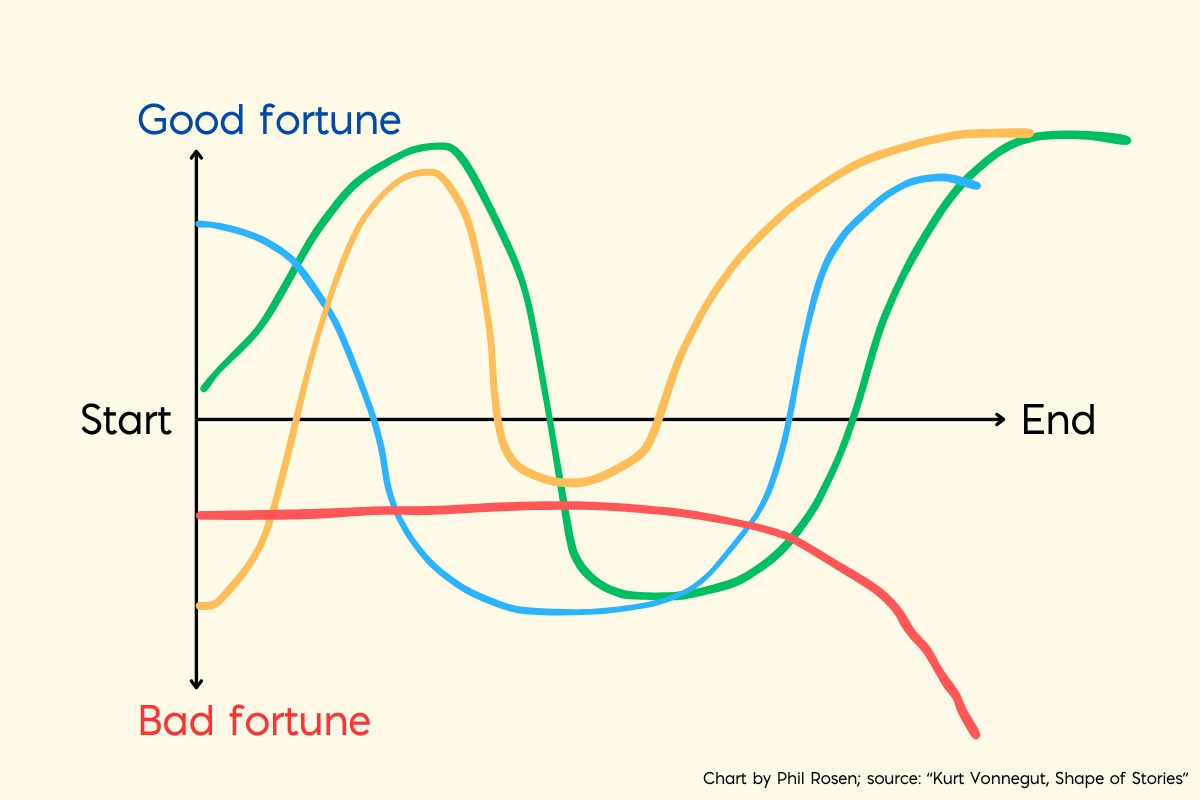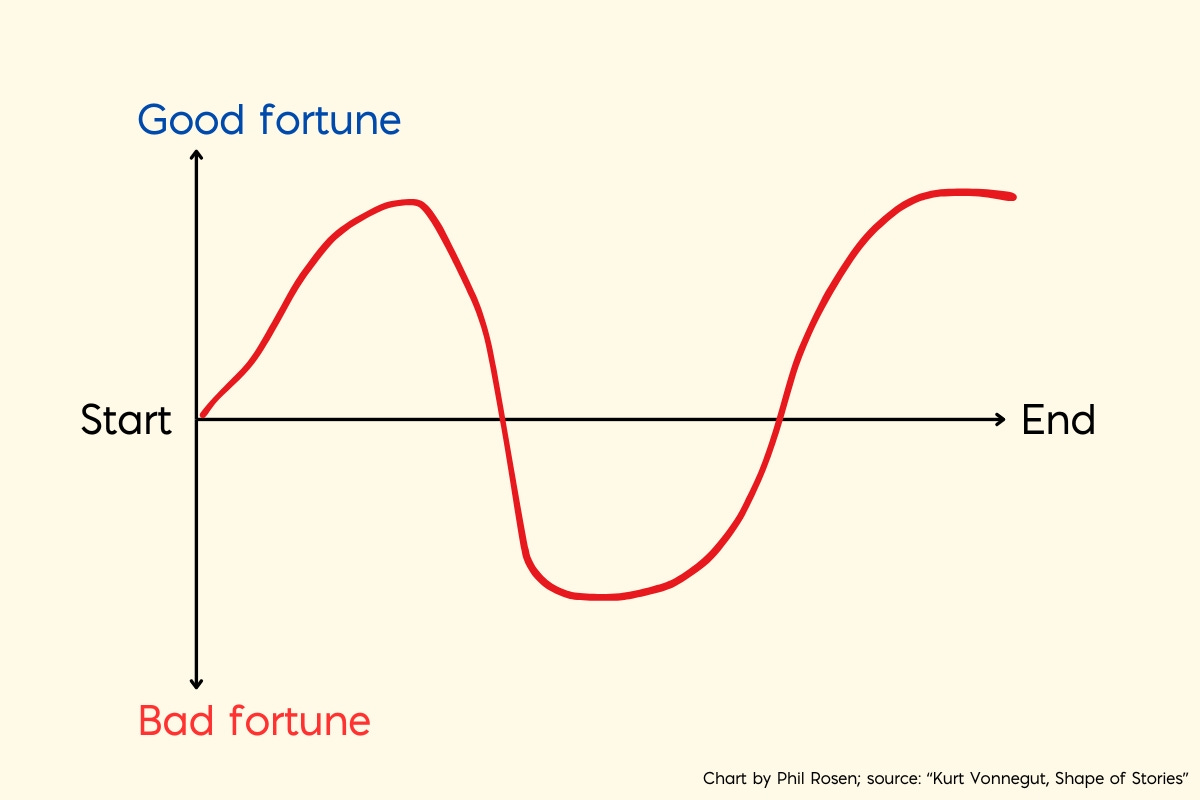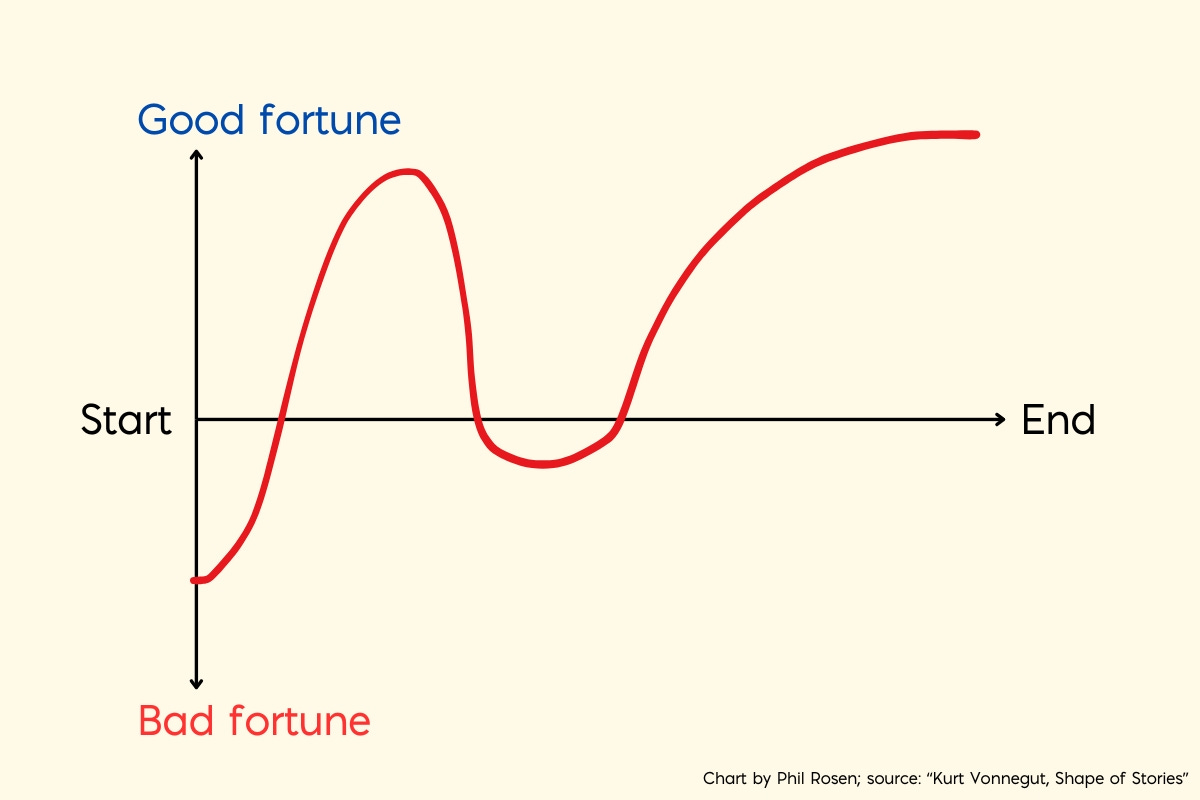
You're telling the same story over and over
But it will always work — across every platform, language, and generation.
I first read Kurt Vonnegut’s novel Slaughterhouse-Five as I wrapped up my senior year of college.
I remember being struck by the way he mixed themes of war and massacre with satire and hope. Immediately after that first book, I read a dozen more of his short stories. He writes with a levity that allows him to unpack dark, complex ideas without bogging down or bumming out readers.
Vonnegut — one of the most prolific authors of the 20th century — writes stories like music. There is a rhythm to his words. Not just his diction, but the shape of his stories from start to finish.
When he was 81 years old, he gave a talk about these shapes. It’s been viewed nearly 2 million times on YouTube.
He illustrates how the most beloved and depraved books and movies across history follow a small handful of archetypes that can fit into a simple chart.
The top of the vertical axis starts with “good fortune” and the bottom is marked “bad fortune.” The horizontal axis runs from a story’s beginning to end. Tongue in cheek, Vonnegut called this the entropy line.
Here’s the shape of the “man in a hole” story — the classic tale of a character with an ordinary or good life who gets into trouble, then figures out how to turn their luck around and emerge better for it.
Everyone loves this one. Think Lion King, Rocky, Die Hard, Inception. This is the shape JK Rowling used for every single Harry Potter book and also what Marvel recycles every other year.
Consider this one. An average-Joe character comes into good fortune, loses it all, but then recaptures that fortune again and happily-ever-after.
This is the classic boy-meets-girl, where the two fall in love, split up, then find each other again. It’s the shape of almost every romantic comedy you’ve ever seen.
Here’s another popular archetype for a bleaker story where the main character is depressive or evil and things only get worse. Like Kafka’s Metamorphosis.
Arguably the most well-recognized shape of all is the rags-to-riches archetype.
The main character starts in a mean existence. Then, fortune turns sharply higher but quickly plummets back down. The new baseline, however, is not as low as before, because of a strong sense of hope for what comes next.
The hope pays off, and happily-ever-after.
This appears everywhere from Cinderella and Oliver Twist to Slumdog Millionaire and The Social Network.
What amazes me about each of these shapes is that they work no matter the medium, language, or era. You can find them in texts as old as the Bible just as easily as you can spot them in contemporary political narratives.
Sure, a TikTok video or a blog post may not be as memorable as a movie or a novel. But any of the above charts can be accommodated at any length without issue.
Now, I first watched Vonnegut’s lecture in 2018. I’m writing about it today because I’ve spent the last week making 60-second videos about financial markets for social media. I didn’t realize this until my fifth day of filming, but I’ve applied the same story structure for each video that I’ve used to write articles for Business Insider, Fortune, Opening Bell Daily, and elsewhere.
Vonnegut’s story shapes, in turn, fit snugly into these structures.
Here’s what I mean. Almost every news article you read will follow a structure like this:
The lede: Attention-grabber
The “nutgraf” or nutshell paragraph: The whole story in one or two sentences, like an elevator pitch for what’s to come
Context: Statistics, details, and characters
Stakes: A twist in a story, what could go wrong, why does this matter, what the payoff could be
Meanwhile: Additional background that is helpful but not essential
Kicker: The last idea you leave the reader with to make them think, act, or investigate further
Newsrooms and classrooms around the world teach some version of this.
The epiphany for me was that this mirrored in the structure that I, like many content creators, have used to script videos:
The hook: Attention-grabber
What: 1 or 2 details and statistics
But: A twist or intrigue to keep the viewer engaged
So: Forward-looking takeaway or what to expect next
Call to action: I ask viewers to sign up for my newsletter
See the similarities?
Vonnegut may have resisted this notion, but his story shapes fit into journalism as effectively as with influencer marketing campaigns.
Notably, when we zoom out even further we can see how these shapes mold around the Hero’s Journey, a meta-archetype which Joseph Campbell famously called the “monomyth.”
His work suggests that every story since forever follows the same universal pattern: separation, initiation, and return.
This framework works well in Hollywood, but it also carries real people through stages of life.
Separation, the first stage, begins with a call to adventure. Today that resembles something like moving out of your parents’ home and attending college. Initiation translates loosely as the formal and informal education you receive during your time away from home. That hard-earned experience comes with bruises.
Then, once the world has had its way with you and you’re wiser for it, you return home to uplift your community and share what you have learned.
In connecting these abstract ideas to tangible actions like writing and filming, I’m hoping to deliver something like utility. One skill nobody regrets picking up is the ability to tell a good story.
One final insight occurs to me which could be even more practical. When you learn to notice a good story, you learn to recognize a life well-lived. This, in turn, opens the door for you to lead a better life in the here and now.
That’s the hope, anyway. It has to be.
Thanks for reading.












